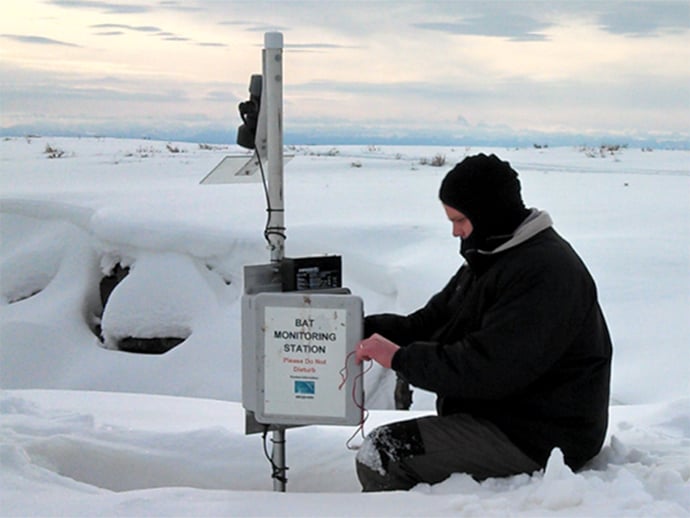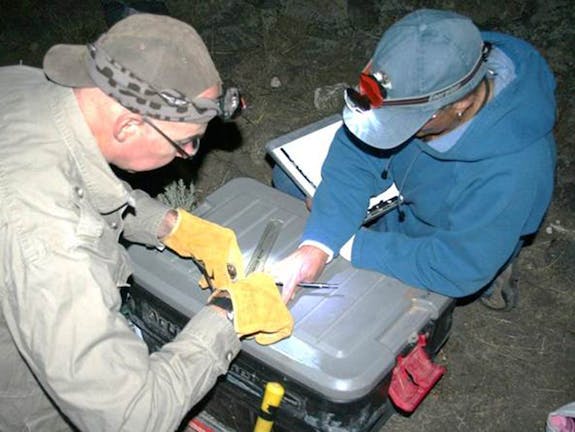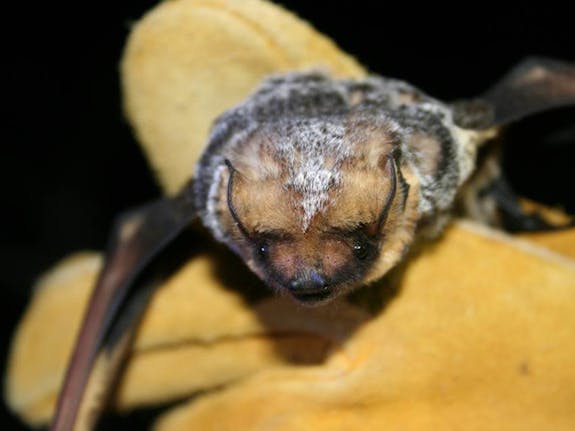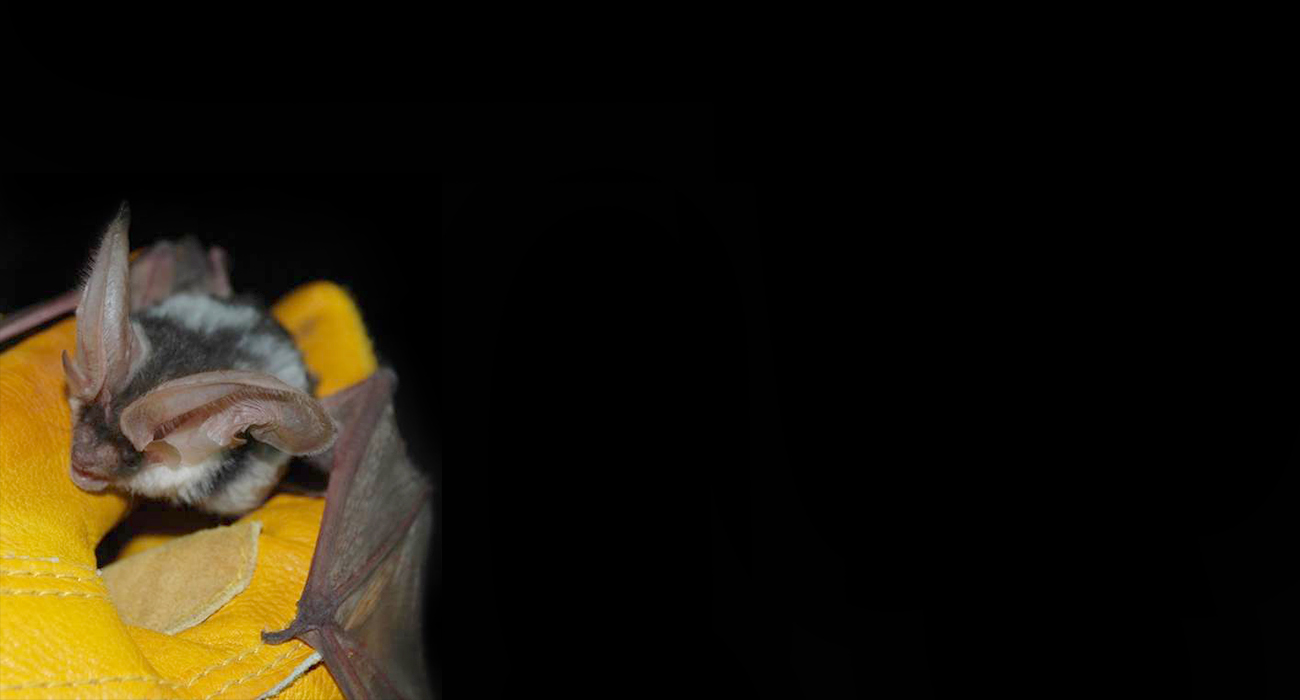Bat Central: As extinction threats mount, eastern Idaho offers refuge, prime habitat
It’s no coincidence that Bat Week is the week leading up to Halloween, but on the U.S. Department of Energy’s Idaho Site, bats are a year-round concern.
Forget about Dracula. Bats are a critical component in a variety of healthy ecosystems, and provide significant agricultural pest control and pollination. Their survival is essential for a sustainable natural environment, and they are under grave threat in large parts of North America from white-nose syndrome, a fungus that thrives in cold temperatures and wakes bats from hibernation.
White-nose fungus has not yet reached Idaho. The lava caves and tubes of the Eastern Snake River Plain are prime hibernation habitat for resident bats, and the deserts and forests of Idaho are prime foraging habitat for both resident and migratory species. The Idaho Department of Fish and Game and the U.S. Fish and Wildlife Service are both keenly interested in where the different species come from, how long they stay, and what can be done to protect them.

A bat monitoring station on the U.S. Department of Energy’s Idaho Site.
Idaho National Laboratory archaeologist Brenda Pace — who puts in scores of volunteer hours coordinating teams to assist the Idaho Fish and Game and other professional wildlife biologists in tracking bats between May and October — has participated in wintertime censuses of hibernating bats on INL ground. Pace’s interest in bats began in the mid-’90s, when she was doing a lot of archaeology work in caves on the 890-square-mile Idaho Site.
“They fill an important niche and they do it in such a unique way,” she said. “They’re amazing consumers of mosquitoes and agricultural pests and they live for a really long time, up to 40 years or maybe more. Once you start learning about them, they’re absolutely fascinating.”
Bats hibernate six to seven months out of the year. One thing you don’t want to do when that is happening is disturb them, because waking up a hibernating bat can be its death sentence. Bats burn fat reserves very slowly in hibernation. If they are roused when there are no bugs to eat, they burn up their reserves and can starve to death.
White-nose syndrome was first detected in the northeastern United States in 2007. The disease is named for the white fungus Pseudogymnoascus destructans that infects skin of the muzzle, ears, and wings of hibernating bats. Since reaching North America, millions of insect-eating bats in 29 states and five Canadian provinces have died. In 2016, WNS was confirmed in Washington and Rhode Island.
Pace and others suspect it will eventually come to Idaho, which is why she would love to hang “Do Not Disturb” signs at the mouth of every cave. When a team goes into a cave to do a census, they carry a permit from the Department of Energy and follow a strict decontamination protocol to reduce the potential for transferring microorganisms between caves. All members are encased in protective clothing, with special attention paid to the boots, which are most likely to bring in any contaminating elements. All in all, it’s a delicate operation. “You want to get in and out as fast as you can, because your very presence can wake them up,” she said.
As the government and private parties search for solutions to white-nose syndrome, the public can play a role in the future of bats by providing habitat and surveying their populations. Beginning in 2014, citizen scientists from the Idaho Master Naturalists and other volunteer organizations joined professional biologists from Idaho Fish and Game, the Bureau of Land Management, U.S. Forest Service, National Park Service and Wastren Advantage, Inc., to conduct a pilot project for mobile acoustic bat surveys in eastern Idaho.

INL archaeologist Brenda Pace and Bill Doering, Wastren Advantage, Inc., during a bat monitoring visit.
The pilot program was a success and now, from May to October each year, Pace coordinates 18 two-person teams — many of them retired from INL — who conduct mobile acoustic surveying, following assigned routes on the desert, in the valleys to the north, and all the way up into Island Park. Once a month, half an hour after sunset, they affix a “Slow Moving Vehicle” sign and flasher, mount a high-frequency broadband microphone on the roof, get their pencils and data sheets ready, and drive 30 miles at 20 mph – the speed at which bats typically fly. The microphone is connected to a bat monitor which detects and records ultrasonic bat echolocation calls for later analysis.
As bats fly through the night sky, they navigate by producing trains of acoustic pulses above the range of human hearing. Each species of bat has unique features to its calls, distinct from the background noise picked up by the microphones. From Big Lost River to Fall Creek to Henry’s Lake, the data are collected and loaded into the computer database. Pace collates the information for transfer to the professional biologists who identify species and analyze the data, which is helping to compile important baseline information in support of conservation planning.

A bat in the gloved hand of a scientist monitoring habitat on the Snake River Plain. Because of the threat posed by white-nose syndrome, protective clothing is essential while taking count in Idaho’s caves.
Once you learn about bats, it’s hard not to care about them. Pace says one of her favorite things to do in summer is camp out at Buffalo Campground in Island Park. About a half-hour after sundown, she will pour herself a glass of wine and go to the water to watch the bugs and bats come out.
“I’ve become a total bat geek,” she said.
Bat species that have been identified in eastern Idaho through mobile acoustic surveying:
- Hoary bat (Lasiurus cinereus)
- Silver-haired bat (Lasionycteris noctivagans)
- Big brown bat (Eptesicus fuscus)
- Townsend’s big-eared bat (Corynorhinus townsendii)
- Little brown myotis (Myotis lucifugus)
- Western small-footed myotis (Myotis ciliolabrum)
- Pallid bat (Antrozous pallidus)
- Western Long-eared myotis (Myotis evotis)
- Long-legged myotis (Myotis volans)
- Yuma myotis (Myotis yumanensis)





